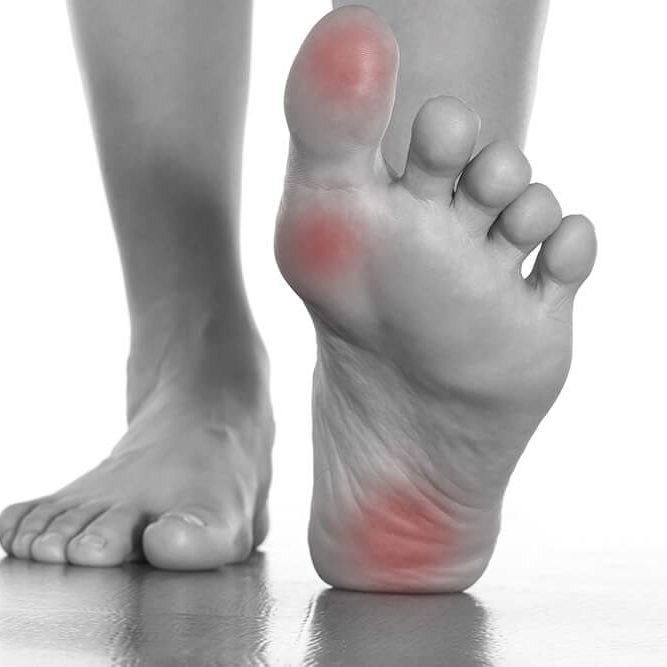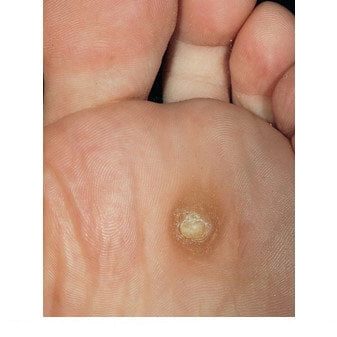What are Corns & Calluses?
Our feet play an important role in getting us around. When we walk or stand, our feet carry the burden of our body weight, as well as bearing the various pressures of movement and the constraints of footwear. Sometimes, pressure placed on the foot becomes out of balance and extra friction falls on particular areas of the foot. When this happens, the body responds to increased pressure by creating thickening of the surface layer of the skin. These hard patches of skin are called calluses and are part of the body’s defence system to protect the underlying tissues. If the cause of the pressure is not relieved, calluses continue to thicken and become larger, causing pain.
Formation of the Corn
If pressure becomes concentrated in a small area, a hard ‘corn’ may develop. Sometimes the pressure of the corn or callus may produce inflammation which can result in acute pain, swelling and redness. Sometimes ‘soft’ corns may form between the toes where the skin is moist from sweat or inadequate drying. These appear white and rubbery and are also caused by excessive friction.
Corns and calluses are most often found on the balls of the feet or the tops of toes. They can also be found on the heels and even along the sides of toenails.


What Causes Corns and Calluses
Calluses and corns are symptoms of underlying biomechanical problems and result because of how our feet interact during dynamic motion with the ground. In some cases they can be early warning signals of more complex foot disorders. Because they are caused by continuous pressure in one particular area, they may indicate abnormalities or deformity in bone structure or in the way a person walks. Ill-fitting footwear and incorrect footwear choices often contribute to calluses and corns as well.
Who Gets Calluses and Corns
Almost everyone! In fact, calluses and corns affect more people than any other kind of foot problem. Some people have a natural tendency to develop calluses because of their skin type. For instance, elderly people have less fatty tissue and elasticity in their feet and because of a lack of padding, calluses may form on the bottom of the foot. Also, people who work in occupations that require them to spend a lot of time on their feet are prone to developing calluses.
Fact
Corn paints, pads, solutions or plasters containing acid can be dangerous, especially if you suffer with diabetes, peripheral vascular disease or circulation disorders. For this reason corn removal pads are not recommended.
Following removal of the corn, footwear modifications may be needed and advised.
Our Approach & Care Management
The most important thing to remember about managing calluses and corns is never do it yourself without seeing a specialist first. Because calluses are generally symptoms of other problems, it is important to have a podiatrist examine your feet to work out what could be causing the pressure. Over-the-counter care management such as corn paint or plasters do not work and can damage the healthy skin surrounding the corn. It is also important that you do not cut corns or calluses yourself. In the confined spaces of a shoe, it is very moist and warm. This provides the perfect breeding ground for infections to proliferate and quickly turn into serious wounds.
Preventing Corns and Calluses and Caring for Your Feet
The best way to prevent the development of calluses and corns is to pay attention to your feet when you feel there is extra pressure on specific areas. Properly fitting shoes are essential, especially if you spend long periods of time on your feet and it is important that you never wear others’ shoes. A moisturiser used daily, will help to keep your skin supple and those containing a mild acid are helpful to remove dead/dry skin.
What Can My FootDr Podiatrist do
Our podiatrist will not only recommend ways to relieve pain and get rid of the corns or calluses, but can also help with isolating the cause and preventing the problem from recurring.
If you feel you may be developing calluses or corns, or you already have one, the best thing to do is seek profession advice and care management from our podiatrist at my FootDr Singapore.
